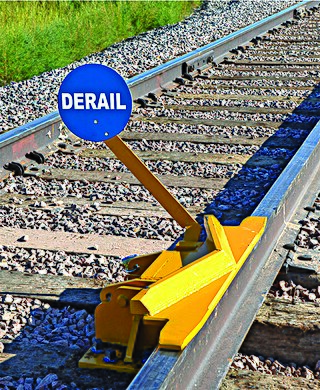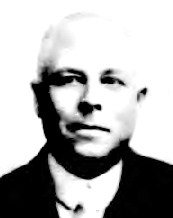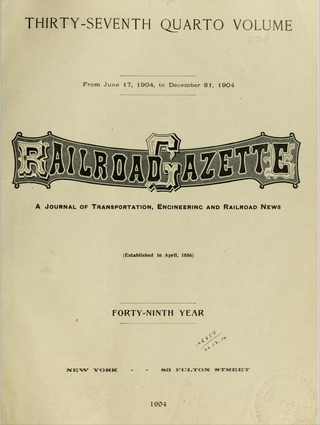
In railway signalling, an interlocking is an arrangement of signal apparatus that prevents conflicting movements through an arrangement of tracks such as junctions or crossings. In North America, a set of signalling appliances and tracks interlocked together are sometimes collectively referred to as an interlocking plant or just as an interlocking. An interlocking system is designed so that it is impossible to display a signal to proceed unless the route to be used is proven safe.
The Atlantic, Waycross and Northern Railroad was formed on March 6, 1911, as a successor to the St. Mary's and Kingsland Railroad. Its charter was to build a line connecting St. Mary's to Fort Valley, Georgia. On the reorganization, stockholders approved a measure to issue $4.8 million in bonds and $1.5 million in new stock to equip the new line, pending approval by the Georgia railroad commission. The railroad was permitted to issue stocks and bonds valuing $6.2 million on June 9, 1911.

A derail or derailer is a device used to prevent fouling of a rail track by unauthorized movements of trains or unattended rolling stock. The device works by derailing the equipment as it rolls over or through it.
Samuel Orace Dunn was an American transportation specialist.

A ballast cleaner is a machine that specialises in cleaning the railway track ballast of impurities.

Wisconsin Central Ltd. is a railroad subsidiary of Canadian National. At one time, its parent Wisconsin Central Transportation Corporation owned or operated railroads in the United States, Canada, the United Kingdom, New Zealand, and Australia.

John Saxby was an English engineer from Brighton, noted for his work in railway signalling and the invention of the interlocking system of points and signals. He was later a partner in the firm Saxby and Farmer. He is regarded as "the father of modern signalling".

Royden Vincent (Roy) Wright was an American Republican Party politician who served in the New Jersey State Senate.
White River Productions is an independent publishing company that specializes in books and magazines targeted to railroad enthusiasts and historians. Kevin EuDaly founded the company in 1992 to published the book Missouri Pacific Diesel Power, which he also authored. Several other titles followed, and the company became his full-time venture beginning in 1996. The company expanded when it took on publishing newsletters and managing membership databases for several railroad historical societies. The company is headquartered in Bucklin, Missouri.

The GN boxcab locomotives were the first electric locomotives purchased by the Great Northern Railway (GN) for use through the Cascade Tunnel. Four locomotives were supplied by the American Locomotive Company; they used electrical equipment from General Electric and weighed 115 short tons (104 t) each.

Railroad Gazette, published as Western Railroad Gazette from its founding until 1870, was a trade journal first published by Stanley C. Fowler, assisted by James J. Schock, in April 1856 at 128 South Clark St., Chicago, which focused on railroad, transportation and engineering topics. Master mechanics read and used the publication to share information about railway matters with one another. An article in the publication documented what was purported to be the first locomotive run in the United States on a railroad, which was stated as performed by the author of the article. It also reported about the Erie Railroad's Rochester Division's electrification and about the opening of the Thebes Bridge. Over time Railroad Gazette editors included Arthur Mellen Wellington, Silas Wright Dunning (1838–1924) and Matthias Nace Forney with Horace Cleveland as an article contributor. The journal was sold by Fowler in 1870 to A.N. Kellogg, who retained Schock.
Walter Theodore Krausch, known as W.T. Krausch (1868–1929), was an American architect, engineer, and inventor who worked for the Chicago, Burlington and Quincy Railroad (CB&Q) from the late 1880s to the 1920s.
Railway Track & Structures (RT&S) is an American trade journal for the rail transport industry, focusing on the fields of railroad engineering, communication and maintenance. It was founded in 1905 as Railway Engineering & Maintenance and is published monthly by Simmons-Boardman Publishing Corporation.
Paul Walter Kiefer was an American mechanical engineer, locomotive designer, chief engineer at New York Central Railroad, and inventor, who was awarded the 1947 ASME Medal.
Simmons-Boardman Publishing is an American publisher, specializing in industry publications. It is headquartered in New York City, New York, and has offices in Chicago, Omaha, and Falmouth, Cornwall, UK. The company was created from a merger of The Railroad Gazette and Railway Age in 1908; the company's name was derived from Gazette's vice president, E. A. Simmons, and editor, William H. Boardman.
Robert Grier Lewis was an American photographer, editor and author in the field of railways.
The Harrison Cut-off is a substantially abandoned north–south rail line constructed by the Lackawanna Railroad for freight and equipment moves, running between Lyndhurst, New Jersey and Harrison, New Jersey and currently owned by NJ Transit.

William Buchanan was an American mechanical engineer. He spent most of his career designing high-speed steam locomotives for the New York Central Railroad including the New York Central and Hudson River Railroad No. 999 locomotive, designed to travel over 100 miles per hour (160 km/h). He also designed and improved freight locomotives for hauling heavy commercial freight. He was an authority on mechanical engineering in America and Europe and was elected to membership of the Institute of Civil Engineers of London.









